Demand for luxury homes in vacation destinations intensified
The number of properties sold for between $1 million and $5 million grew 103% from 2019 to 2022*, and many of the places where these homes are located are also frequented by those who are looking to take a holiday from the everyday. In the U.S., most of the top 10 top core-based statistical areas (CBSAs) with the largest home equity increases from 2020 to 2021 were vacation destinations.
Freedom of Movement Increases Luxury Home Market
When it comes to vacation homes, the old aphorism that real estate is all about location holds true. From Lake Tahoe and West Palm Beach to Provence and Marbella, sales of homes cresting $20 million are growing. Hawaii, France, Miami and Dubai, all locations where people traditionally look to vacation, have seen luxury home sales surge 234%, 120%, 152% and 200%, respectively between 2020 and 2021, according to Knight Frank’s The Wealth Report 2021. Destinations such as Provence, Marbella, London and Ibiza are all resort communities whose allure attracts ultra-high-net-worth individuals from around the globe.
Even more interestingly, as some of these more traditional luxury markets top the charts with multimillion-dollar homes, buyers have begun looking on the outskirts of these areas as well as neighboring communities to find good deals.
“Ultra-luxury home sales – those over $40 million – actually spread out geographically beyond just the areas we think about traditionally as ultra-luxury markets. Los Angeles is a top market, but what was interesting over the last year is Riverside, which is an adjacent market to LA, also had the biggest sale they’ve ever recorded of over $40 million,” said CoreLogic Interim Lead of the Office of the Chief Economist Selma Hepp.
North American locations such as Summit Park, Utah and Hailey, Idaho — both locations just outside popular ski zones — are topping the charts for strong demand and equity increases. Between Q4 of 2020 and Q4 of 2021, homeowners in these locations realized average equity gains of $264,200 and $166,500, respectively, according to data from CoreLogic’s Q4 2021 Home Equity Report.
Increased Wealth
“There are as many as 3.5 millionaires globally, and these are individuals who have a net worth of $5 million or more,” said Hepp. “A lot of them live in Asian cities, and Tokyo tops the list of cities with the most high-net-worth individuals.”
While the largest number of multi-millionaires reside in Asia, the United States experienced the biggest increase in ultra-high-net-worth individuals (those with $30 million or more in assets) in 2021, with a 12% jump in this population. At the same time, the number of mega-millionaires also grew in the U.S.
This influx of capital has allowed wealthy individuals to invest in additional properties and continue growing their asset portfolio. Purchases of second homes skyrocketed from 23% in 2020 to 32% in 2021 with jumps in the seven-figure real estate market showing significant gains, per data from The Wealth Report. In 2021 alone, homes valued between $1 million and $5 million saw sales increase by 113% year over year, according to CoreLogic data.
Along with individuals whose financial wherewithal allowed them to purchase supplemental properties, overall investor activity has increased. Investors made a comeback in 2021, and by February 2022, investors made 28.1% of all single-family purchases, a record high according to CoreLogic’s data that goes back to 2011.
Home price appreciation has contributed to an overall increase in individual wealth. According to CoreLogic’s most recent Home Price Insights report, home prices increased by 20.2% in May 2022 when compared with May 2021. These gains were reflected in the augmentation of individuals’ net worth. Real estate and other tangible assets added $10 trillion in new wealth, according to The Wealth Report.
Demand for More Space
Demand for single-family residences has increased in recent years as people have moved out of densely populated areas where apartment living is common. Data from CoreLogic’s Home Equity Report suggests that the real estate boom goes beyond the suburbs, which are typically associated with single-family structures, and is trickling into micropolitan areas or zones with an urbanized population of 10,000 to 50,000. CoreLogic data shows detached homes experienced a 42% increase between March 2020 and May 2021.
According to data from the CoreLogic Economy Team, half of these areas in the U.S. where populations are growing thanks to out-migration are in the Mountain-West and close to ski resorts.
“In 2021 we saw an increase in second home purchases in holiday spots. This is due to a pandemic-induced shift in preferences for lower-density living with great outdoor amenities,” said CoreLogic economist Thom Malone. “How long this will last remains to be seen, but these areas were growing fast for many years, so it is fair to say this amplified a pre-existing trend that will stick around to some degree.”
Data from PWC support this observation that out-migration from expensive urban markets to smaller, more affordable areas is a trend that will stay the course through 2022.
Continued constraints in the U.S. in housing stock, as well as heightened demand for second homes, will likely continue this upward slope for prices in vacation destinations, which could lead to an increased number of buyers looking to adjacent markets to purchase second properties.
For those that pay close attention to listings and are interested in keeping up to date with housing trends, follow CoreLogic’s economic experts as they dive into the latest data-driven discoveries to help navigate the market and discover dream homes.
*CoreLogic data was pulled for the first six months of each year between 2019 and 2022.


